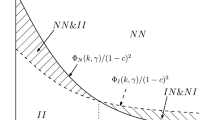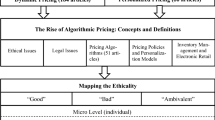Abstract
This paper investigates the different terms of strategic interactions (non-cooperative, simultaneous move): wholesale versus retail pricing—between Bertrand competing retailers and an upstream oligopoly. The crucial extension is that retailers can play a significant role and this can turn conventional wisdom upside down, e.g.: retail competition need not benefit the upstream firms and wholesale pricing can dominate retail pricing in spite of double marginalization because of the incentives it provides to retailers. In addition, the consequences are investigated of differentiating both pricing instruments either at the downstream (this is motivated by Apple’s entry into the ebook market) or at the upstream level.






Similar content being viewed by others
Notes
I owe the references in this section up to here to the helpful comments from an anonymous referee.
See Foros et al. (2013) for further discussions about the demand parameters. In a first version, the impact of the price charged by the other retailer for the other product was ignored. The results are fairly similar and available upon request.
References
Björnerstedt J, Stennek J (2007) Bilateral oligopoly—the efficiency of intermediate goods markets. Int J Ind Organ 25:884–907
Bourreau M, Hombert J, Pouyet J, Schutz N (2011) Upstream competition between vertically integrated firms. J Ind Econ LIX:677–713
Choi SC (1991) Price competition in a channel structure with a common retailer. Mark Sci 10:271–296
Dawar N (2013) When marketing is strategy. Harvard Bus Rev 100–108
Dobson PW, Waterson M (2007) The competition effects of industry-wide vertical price fixing in bilateral oligopoly. Int J Ind Organ 25:935–962
Foros Ø, Kind HJ, Shaffer G (2013) Turning the page on business formats for digital platforms: does Apple’s agency model soften competition? In: CESifo
Gabrielsen TS, Johansen BO (2013a) Resale price maintenance and up-front payments: achieving horizontal control under seller and buyer power, mimeo. Department of Economics, University of Bergen, Norway
Gabrielsen TS, Johansen BO (2013b) The opportunism problem revisited: the case of retailer sales effort, mimeo. Department of Economics, University of Bergen, Norway
Gaudet G, Van Long N (1996) Integration vertical foreclosure, and profits in the presence of double marginalization. J Econ Manag Strategy 5:409–432
Horn H, Wolinsky A (1988) Bilateral monopolies and incentives for merger. RAND J Econ 19:408–419
Inderst R (2007) Leveraging buyer power. Int J Ind Organ 25:908–924
Jansen J (2003) Coexistence of strategic vertical separation and integration. Int J Ind Organ 21:699–716
Lee E, Staelin R (1997) Vertical strategic interaction: implications for channel pricing strategy. Mark Sci 16:185–207
Matsushima N (2006) Industry profits and free entry in input markets. Econ Lett 93:329–336
Milliou C, Petrakis E (2007) Upstream horizontal mergers, vertical contracts, and bargaining. Int J Ind Organ 25:963–987
Mills DE (2007) Quasi-partnerships in distribution. Rev Ind Organ 31:155–168
Naylor RA (2002) Industry profits and competition under bilateral oligopoly. Econ Lett 77:169–175
Rey P, Stiglitz J (1995) The role of exclusive territories in producers’ competition. Rand J 26:431–451
Rey P, Verge T (2010) Resale price maintenance and interlocking relationships. J Ind Econ LVIII
Richards TJ, Patterson PM (2005) Sales promotion and cooperative retail pricing strategies. Rev Ind Organ 26:391–413
Romano RE (1994) Double moral hazard and resale price maintenance. Rand J Econ 25:455–466
Acknowledgments
I acknowledge helpful comments from Christoph Graf and three anonymous referees.
Author information
Authors and Affiliations
Corresponding author
Appendix proofs
Appendix proofs
1.1 Proposition 1 and Corollary 1
The equilibrium follows directly from solving the three first order conditions (14), (16), and (17). Substituting the just computed strategies and elementary simplifications yields,
The denominator is negative for all \(k>\) k since the first term of the product must be negative for \(k>\) k while the second is positive (again at least for \(k>\) k). Therefore the numerator in (58) is negative only for \(k>2\) k turning the ratio positive and thus verifies (21).
The comparison with the Bertrand vertically integrated duopoly is less trivial. Considering the difference in retail prices,
this difference is only positive if the numerator is negative, because as above the denominator is negative due to the first term (the second is the positive one from above). Combining, this leads to the claimed condition ( 22).
Considering the difference in promotions, the comparison with the first best is straightforward due to the same negative denominator as in (58),
but less clear cut for the comparison with the Bertrand oligopoly,
The denominator is the negative one from the above comparison of prices and the last term of the numerator is a quadratic function,
that is positive for the indicated domain of smaller \(\gamma \)s.
The computation of the retail monopoly’s profit is straightforward after substituting the equilibrium prices, margins and efforts and the upstream profits are calculated in the same way.
QED.
1.2 Proposition 2
Including the remark, it is necessary to prove that no interior solution \( 0<s<1\) exists irrespective who controls \(s\).
If the upstream firm chooses \(s\), as assumed in Proposition 2, the derivatives of its profit functions are,
Clearly, no sensible interior solution—equating both equations above to zero, irrespective of the retailer’s effort—can exist. The upstream firm sets its share at the upper bound \(s=1\) due the positive derivative (64).
If a retailer can maximize its profit \(\pi \) subject to the additional instrument \(s_{i}\ge 0\) and defining the Lagrangian,
leads to the following necessary optimality conditions (assuming symmetry on the right hand side):
Substituting the implied optimal effort, \(e=( 1-s) P/k\), and symmetry in prices into the share equation yields,
Therefore, the Kuhn–Tucker multiplier \(\mu \) is positive iff sales are positive. Thus the constraint must be binding, \(s=0\). This is not surprising given the pure transfer nature of the shares. The retail monopoly’s ability to fix them suggests that it surrenders nothing, i.e., \(s=0\), but supports this by the corresponding optimal promotion effort.
The necessary optimality condition for an upstream firm is for any \( s_{i}^{j} \) to choose the price that maximizes the profits up and downstream integrated such that \(P^{B}\) characterized in (9) results.
Both results extend naturally to oligopolistic retailers.
1.3 Proposition 3
An upstream oligopolist’s profit under retail pricing is given by (29) and here denoted \(\pi _{i}( r) \), where the argument \(r\) stands for retail pricing. Under wholesale pricing the upstream profit of firm \(i\) (the argument \(w\) indicates the wholesale pricing arrangement) is
Taking the difference
and focussing on the numerator of the second ratio, the first term turns negative for \(k>2\) k. This implies the claim because the last term is positive for all \(k>\) k. QED.
1.4 Proposition 4
The Nash equilibrium follows immediately from solving the three first order conditions (30)–(32). The upstream \(( \pi _{i}) \) and downstream \(( \pi ^{j}) \) profits follow then directly after substituting the equilibrium outcome.
The claims about the wholesale
and retail price differences between retail monopoly and oligopoly (superscript \(a\))
follow because the denominator is negative due to
and
Computation of the upstream profits facing a retail duopoly are,
and subtracting that from (70), i.e. the profit of upstream firm \( i\) if facing a retail monopoly, yields,
The denominator is negative, the last term in the numerator is definitely negative and the sign of the term in the middle is positive iff \(k>2\) k, which verifies this claim.
Taking the differences in demand between oligopolistic and monopolistic retailer yields a fairly similar expression,
which verifies the claim because the numerator is positive for \(k\) satisfying (38) and (by recall), the denominator is negative since it is \((1-\beta )\) times the denominator in (73).
QED.
1.5 Proposition 6
Departing from the corner equilibrium, \(s=1\) and \(e^{b}=0\), the first order conditions of the upstream firms are with respect to the wholesale,
and the retail price
The corresponding conditions for retailer \(a\) (\(b\) has no leverage in this set up) concerning the margin
while effort follows from the usual condition,
Solving all four conditions yields the claimed equilibrium.
Substituting this solution into the profit of retailer \(a\) yields (46). Taking the difference in retail prices confirms the claim since,
Computation of the sales,
and taking the difference
verifies the condition (45).
QED.
1.6 Proposition 7
Starting upstream, assuming the corner equilibrium, \(s=1\) and \(e_{2}^{j}=0\), and a symmetric outcome, the first order conditions of \(i=1\) setting the wholesale price is,
and correspondingly for \(i=2\) for setting its retail price,
The corresponding conditions for the two retailers are confined to choose margins and efforts for product \(i=1\) only,
Solving all four conditions for \(( p,P,m,e) \) yields the equilibrium in Proposition 7.
Substitution of this equilibrium (including the corner solution elements) yields the profits (55) and (56). Taking the difference,
results in quadratic polynomial which is positive at k and thus turns negative at the second a larger root, which is the one given in ( 57).
QED.
Rights and permissions
About this article
Cite this article
Wirl, F. Downstream and upstream oligopolies when retailer’s effort matters. J Econ 116, 99–127 (2015). https://doi.org/10.1007/s00712-015-0443-7
Received:
Accepted:
Published:
Issue Date:
DOI: https://doi.org/10.1007/s00712-015-0443-7




